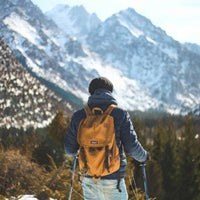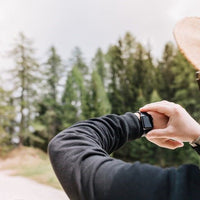This is a Guest Post; please see the following privacy policy for details
In the vast expanses of the United States, the mountain regions stand as bastions of adventure, offering a unique blend of exhilarating hikes and tranquil riverside pursuits.
These landscapes invite explorers to traverse rugged peaks, where panoramic views reward every step, and to follow the gentle streams that carve through valleys, offering solace and excitement in equal measure.
Whether it's the call of the wild that draws you to the heights or the serene flow of water that guides your way, the US mountain regions are a testament to nature's splendid duality.
Here, every trail leads to discovery, and every river tells a story, beckoning adventurers to immerse themselves in the beauty that lies between peaks and streams.
Kayaking Essentials
Embarking on a kayaking adventure amidst the US mountain regions is not just about paddling through the waters; it's a journey that requires preparation, understanding, and the right equipment.
Kayaking blends the art of exploration with the science of navigation and safety, making the selection of gear a critical step in ensuring a memorable and secure experience.
The essentials range from choosing the appropriate kayak to understanding the significance of gear and techniques that enhance your journey.
This segment outlines the foundational elements necessary for kayaking enthusiasts, ensuring they are well-equipped to embrace the rivers and streams that weave through the mountains.
The Importance Of Having The Right Kayak
Selecting the right kayak is paramount to your experience on the water.
This choice influences stability, comfort, and maneuverability, directly impacting your ability to explore and enjoy the riverside pursuits.
Kayaks come in various shapes and sizes, each designed for specific types of water and activities.
For instance, touring kayaks are longer and narrower, offering speed and efficiency for long-distance journeys, while whitewater kayaks are compact and robust, designed to handle turbulent rapids.
Recreational kayaks strike a balance between comfort and versatility, making them a popular choice for beginners and casual paddlers.
Understanding your personal needs, the nature of your adventures, and the characteristics of the waterways you intend to explore is crucial.
A well-chosen kayak acts as an extension of the paddler, seamlessly integrating with the rhythm of the rivers and enhancing the overall experience in the US mountain regions.
Essential Gear For Comfort And Protection
Equipping yourself with the right gear is essential for comfort and protection during your kayaking adventures, ensuring a safer and more enjoyable experience
- Personal Flotation Device (PFD): A crucial safety item, personal flotation devices come in standard buoyant foam and inflatable types. The standard foam life vests are common and recommended for their reliability and safety. For comfort, inflatable vests offer an alternative, but ensuring they're suitable for your kayaking environment is important.
- Sunglasses and Hat: Protecting yourself from the sun is vital. Polarized sunglasses shield your eyes from harmful UV rays and the glare off the water. A wide-brimmed, breathable hat can provide additional protection against sunburn and heat, keeping you comfortable during your journey.
Gear For Convenience And Safety
Selecting gear that offers convenience and enhances safety is crucial for any kayaker, ensuring that every journey is as enjoyable as it is secure.
- Dry Bag: Keeping your belongings dry is essential when kayaking. A waterproof dry bag secures your items from water damage, which is especially important for electronics, snacks, and spare clothing. Opt for a bag that's easy to attach to your kayak, ensuring it doesn't get lost during your trip.
- Water Shoes: To navigate the varied terrain both in and out of the water, water shoes are indispensable. They provide protection against sharp rocks and slippery surfaces. Depending on the conditions, you may choose between open-toed for casual paddling or closed-toed for more rugged environments
Making Memories - Photography While Kayaking And Hiking
Capturing the essence of your adventures in the US mountain regions through photography offers a unique way to preserve memories of the landscapes between peaks and streams.
Whether kayaking through serene rivers or hiking rugged trails, understanding the art of photography in these settings enriches the experience.
Capturing The Perfect Shot
Photography while kayaking and hiking requires attention to detail and an understanding of the environment.
Depth, isolation, perspective, and balance are key elements to consider.
Utilizing the foreground, midground, and background can add a three-dimensional feel to your images, making scenes more immersive.
Isolating subjects against solid backgrounds or using negative space effectively can make your subjects pop, drawing the viewer's eye across the image.
Experimenting with different perspectives and angles can dramatically alter the photo's impact while balancing the visual weight of elements creates equilibrium or intentional tension.
Editing And Post-Processing Techniques
The magic often happens in post-processing, where raw images transform into captivating stories.
Choosing between raw or JPEG formats affects your editing flexibility, with raw offering more control over adjustments without losing quality.
Techniques such as exposure adjustments, white balance correction, cropping for composition, and applying filters or effects can significantly enhance your images.
Local adjustments and layering in editing software allow for precise edits, enabling photographers to fine-tune their images to perfection.
Safety And Ethics
While pursuing the perfect shot, prioritize safety and ethical considerations.
Know the trail, prepare for emergencies, and respect wildlife by keeping a distance and avoiding flash photography.
Tread lightly on the environment by following Leave No Trace principles and being mindful of your impact on ecosystems and local communities.
Ethical photography respects cultural norms, seeks consent when photographing people, and avoids manipulation that misrepresents reality.
Final Remarks
The journey through the US mountain regions, from the exhilaration of kayaking down serene rivers to the triumph of conquering rugged peaks, encapsulates the essence of adventure.
This exploration not only tests our limits but also offers a canvas to capture the indelible moments that nature generously provides.
Through careful selection of gear, understanding the nuances of photography, and adhering to ethical principles, adventurers can ensure that each expedition is both memorable and respectful of the natural world.
As we traverse these landscapes, let us cherish and preserve the beauty and stories they hold, ensuring they continue to inspire generations to come.




1 comment
Safecastle
it seems like the author is really passionate about kayaking and hiking in the US mountain regions. They describe the scenery as being beautiful and the activities available as being diverse. The article also provides some helpful tips on choosing kayaking gear, photography basics, and safety.